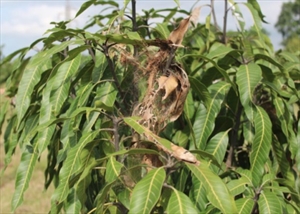Mango flower webworm
Pacific Pests, Pathogens, Weeds & Pesticides - Online edition
Pacific Pests, Pathogens, Weeds & Pesticides
Mango flower webworm (334)
Dudua aprobola; previously known as Platypeplus aprobola.
South and Southeast Asia, Africa, Oceania. It is recorded from Australia, Cook Islands, Federated States of Micronesia, Fiji1, Kiribati, Palau, Papua New Guinea, Samoa, Tonga, and Tuvalu.
Mango. It is also found on many other fruit trees, including cashew, guava, litchi, Malay apple, Calophyllum inophyllum, ornamentals, such as rose and dahlia, and weeds. Peanut is also a host.
The larvae do the damage. They eat the flowers and the young fruits, and attack the flower stalks. Flowers and stalks are webbed together (Photo 1). The leaves are also webbed together, and the edges of the leaves rolled, with the larvae feeding inside.
The eggs are laid between veins on the undersides of leaves. The mature larvae are yellowish green, except for the black head, and the first two pairs of legs which are also black (Photo 2). The adult is pale brown with dark markings, and a wingspan up to 20 mm (Photo 3).
There are several webworms on mango reported from the Pacific islands. From Fiji, there is the flower looper, Chloroclystis species; flower spike caterpillar, Nanaguna breviuscula; and flower webworm, Cryptoblabes plagioleuca1. They, and Dudua aprobola, are all said to be common on mango, but the impact is unknown.
In India, Dudua aprobola was the most damaging of several webworms that attack mango. It was thought likely to be of economic importance from its effects on both leaf and fruit production.
Look for the webbing on the leaves and flowers. Look for yellowish green larvae with black heads under the webbing or in rolls on the leaves.
NATURAL ENEMIES
Egg and larval parasitoids are reported from India, and so are several predatory spiders. It is important to find out what are present locally. In Fiji, no control treatments were recommended against any of the several species present, and may mean that webworms are being controlled by natural enemies1.
CULTURAL CONTROL
If chemical control is required, prune trees to a height that they can be reached by pesticide application.
CHEMICAL CONTROL
In the unlikely event that chemical control is required, use Bt (Bacillus thuringiensis), but note the following:
- The spray needs to be applied carefully so that there is good coverage of the shoots and flowers as the insecticide has to be eaten by the larvae to kill them.
- Eggs are not susceptible to Bt.
- Small larvae are more susceptible to Bt than fully grown ones.
- Use Bt as soon as webbing is seen.
- Avoid using broad-spectrum insecticides (such as pyrethroids and organophosphates) as they will kill natural enemies.
____________________
When using a pesticide, (even a biopesticide) always wear protective clothing and follow the instructions on the product label, such as dosage, timing of application, and pre-harvest interval. Recommendations will vary with the crop and system of cultivation. Expert advice on the most appropriate pesticide to use should always be sought from local agricultural authorities.
AUTHOR Grahame Jackson
1Information from Swaine G (1971) Agricultural Zoology in Fiji. Her Majesty's Stationery Office. London; and (plus Photo 1) Soumya BR et al. (2017) Diversity and economic status of Lepidopteran insect-pest on two major varieties of mango. Journal of Entomology and Zoology Studies 5(3): 838-843. (http://www.entomoljournal.com/archives/2017/vol5issue3/PartL/5-2-192-716.pdf); and from Dudua aprobola. Wikipedia. (https://en.wikipedia.org/wiki/Dudua_aprobola). Photo 2 Dudua aprobola (Meyrick) (2013). ICAR-National Bureau of Agricultural Insect Resources. Photo 3 Gerald McCormack, Cook Islands Biodiversity & Natural Heritage. (http://cookislands.bishopmuseum.org/).
Produced with support from the Australian Centre for International Agricultural Research under project PC/2010/090: Strengthening integrated crop management research in the Pacific Islands in support of sustainable intensification of high-value crop production, implemented by the University of Queensland and the Secretariat of the Pacific Community.






